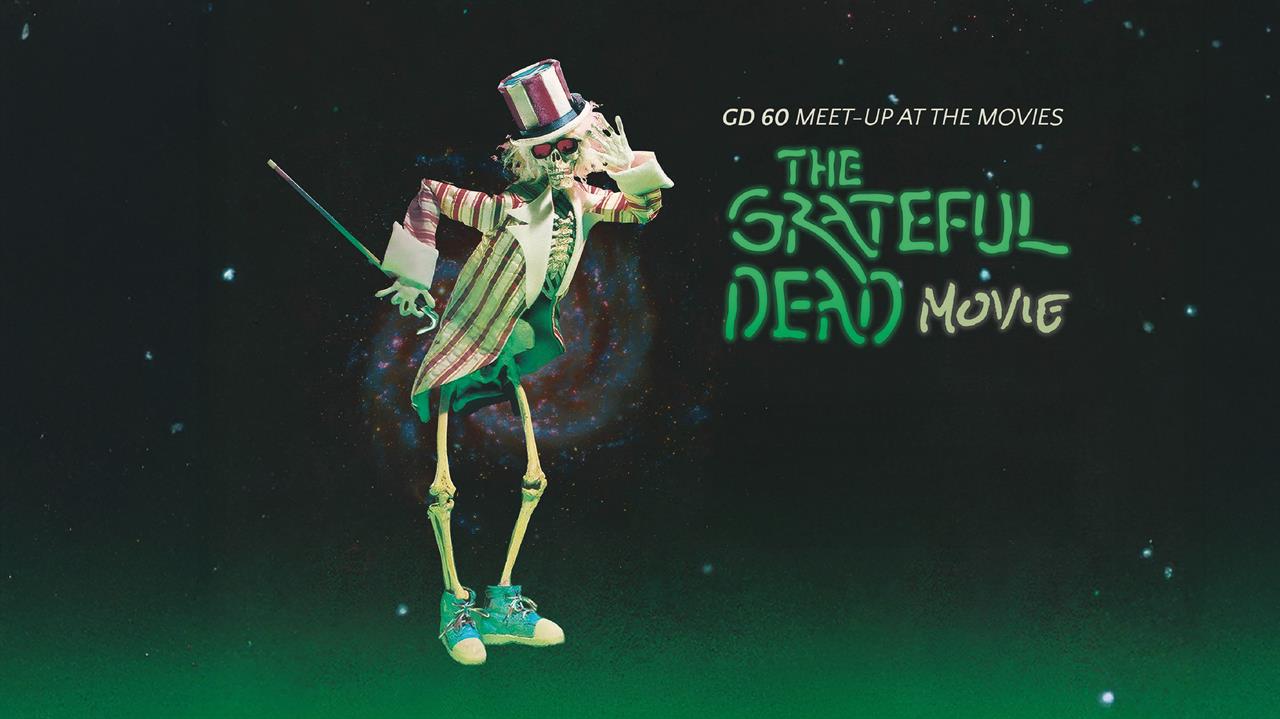The annual event known as Grateful Dead Meet Up at the Movies has bounced around the Burlington, Vermont area over the years, but the yearly event may have found a home outside the Queen City itself at the Majestic 10 in Williston, Vermont.
The presentation of The Grateful Dead Movie for 2025’s Meet Up was particularly appropriate. There was no such happening the year prior, and the latest entry in the series, dating back to 2011, corresponds to the iconic band’s sixtieth anniversary. And while the 1977 film has been presented a handful of times in theaters before, it has certainly aged well as a document of the iconic band at the peak of its powers.
Apart from the opening animation a bit too derivative of the Beatles Yellow Submarine, there’s no sense of campy nostalgia about the movie or the times in which it was filmed. In fact, there might’ve been more sentimental angst in play at the time of the occasion, specifically October of 1974 at Winterland in San Francisco: the Grateful Dead were planning to go on hiatus after this run of five shows, and their return to active status afterward was very much up in the air.
As a result, the airing of the film now, more than half a century past its creation, carries its own significance, especially in light of the fact that the band itself lasted another twenty-five years. Multiple perspectives thus reverberate through the interspersal of (mostly) concert footage with interviews with band members and fans, but most notably with figures who have become famous within Grateful Dead history in the interim.
To the credit of the current Grateful Dead organization, there is no after-the-fact identification of these individuals with subtitles. Now-famous recordist Betty (Cantor-Jackson) appears in a short snippet of conversation within the first hour, while an amusingly brief segment features Bob Weir with the late John Perry Barlow, lyricist for the singer/guitarist. And keyboardist Ned Lagin, mentioned near the very outset of the two-hour and fifteen-minute duration, is shown near the end of the film on an extended version of “Morning Dew.”
That selection rightfully closes The Grateful Dead Movie, as it did so many of the group’s live shows. In this current context, that placement is all the more appropriate as it bookends performance content that the band regularly proffered as a finale to their concerts over the course of its career, including most prominently (and euphorically) “Sugar Magnolia.”
But the elegiac tone of the aforementioned composition deepens in watching and hearing Jerry Garcia seemingly lost in the rapture of guitar improvisations leading into the tune (wherein there are some hints of “Dark Star”). His hair and beard black above a comparatively trim physique, and singing with supple grace, this is the titular leader of the Grateful Dead, like the group itself, at the apex of inspired creativity.
Which is to say the unit is open to improvisation every step of the way, on any given song, becoming increasingly focused in pursuing its possibilities as on the lengthy take of “The Other One:” the open-ended playing after the vocal segments evolves into a series of segues including “Spanish Jam” and “Mind Left Body Jam,” all from October 17, 1974.
Perhaps not coincidentally, the sextet including Keith Godchaux on pianos and spouse Donna Godchaux on (sometimes intrusive) vocals is in place on stage before the massive ‘Wall of Sound.’ Interestingly, too, the depicted assembly of the monolithic apparatus goes unexplained, even though its use for these shows marked its obsolescence.
Restraint in the distribution of The Grateful Dead Movie over time since its original premiere is an extension of the original composition of the film. Captured with multiple cameras, the content wasn’t adorned with cosmetic effects after the fact; some modest color tinting applied to a group of dancers is the only such ornamentation.
Much of the music within is a fitting soundtrack to images of the attendees inside and out of the Bay Area, California venue. But the juxtapositions make for entertaining a series of contrasts: alternately a mentor and a nemesis of the psychedelic warriors, late impresario Bill Graham appears at three junctures, most notably one in which he introduces the Dead’s equipment crew for a lusty round of applause from the attendees.
Elsewhere, Weir good-naturedly points out the return of estranged drummer Mickey Hart (who had left the group in February of ’71), while Phil Lesh engages in some humorous repartee with a camera operator. Garcia himself shows up in an amusing piece of monologue, recounting an incident in which he pushed the aforementioned bassist down a short flight of stairs after a gig.
The now-deceased titular leader of the Grateful Dead giggles toward the end of his anecdote, an amusing occurrence which also elicited a corresponding response from some of the attendees in the Green Mountain theatre. Yet that was the only such instance of overt reaction to the movie during its 2 pm showing on August 16th.
Given the late summer heat outside, it only makes sense that a total of ten in the seats wouldn’t necessarily make for a particularly boisterous gathering. But that only further begs the question of whether the audience was larger and more vociferous at the Thursda,y August 14 slot. Or whether they noticed the audio hadn’t been fine-tuned for music (as opposed to movies), and if the house lights went back down, after the credits rolled, for nearly twenty bonus minutes of “China Cat Sunflower” and “I Know You Rider?”
Such minor distractions didn’t seem to matter Saturday, at least judging by the beaming expressions of at least some of those afternoon moviegoers in the lobby post-show. Those wide smiles spoke to the ongoing wisdom of The Grateful Dead Meetup at the Movies.
Source link
